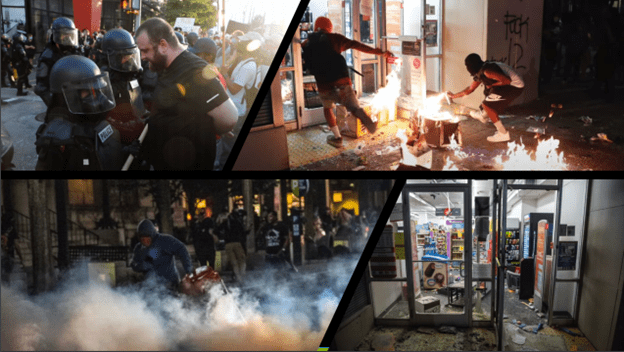
RALEIGH — Throughout the month of June, protests and riots associated with the death of George Floyd took place in multiple cities in North Carolina. Many of the protests spanned several days and were often followed by looting, arson and property damage to public property and businesses.
North State Journal has received information from the North Carolina State Highway Patrol (NCSHP) pertaining to manhours and costs. First Sergeant Michael Baker with the NCSHP responded to our requests, noting that due to security reasons he couldn’t provide the number of officers deployed to each protest nor the number of officers protecting the governor on the dates we inquired about.
“We are very fortunate to report we have not had any members injured during the protests in question,” said Baker in an email to North State Journal, which included details of the cost and manpower hours associated with the protests.
A breakdown of the data from NCSHP by protest location shows that between manhours and gas usage, protests in nine locations around the state cost a total of $304,695. Just over 8,390 manhours were worked by NCSHP officers covering the riots and protests, costing taxpayers $273,505. Additionally, $31,189 was spent on gas for NCSHP vehicles.
The Associated Press had previously reported that around $2.2 million was spent by law enforcement to cover the protests and nightly rioting. According to their reports, NCSHP spent almost $150,000, but that figure did not include costs after the first week of June. The total cost figure obtained by North State Journal from NCSHP is more than double the previously reported amount and covers dates through June 14.
The costliest protest location was Raleigh, coming in at $164,300 and spanning a time period from May 30 to June 12. Charlotte came in second, costing around $71,841 during the period spanning May 30 to June 14.
| Protest Locations | Dates | Costs: Manpower + Gas |
Hours Worked |
| Buncombe | June 1 | $19,925.67 | 581.5 |
| Charlotte | May 30-June 14 | $71,841.28 | 2005.75 |
| Cumberland (3) | May 31-June 1, June 1-2, 5-7 | $24,268.83 | 558.5 |
| Pitt | June 1 | $4,180.31 | 118.5 |
| Raleigh | May 30-June 12 | $164,300.03 | 4,577 |
| Rowan (2) | June 1 and June 2 | $8,439.69 | 211.5 |
| Wake | June 1 | $8,185.99 | 243 |
| Wilson | June 2 | $2,130.42 | 54 |
| Yancey | June 2 | $1,423.31 | 41 |
The Wake County Sheriff’s Office reported $400,000 in costs, the State Capitol Police spent just over $48,000 and Alcohol Law Enforcement officers spent $27,000 in pay. It was also reported that the activation of the North Carolina National Guard members cost $725,000.
In initial reports by the Associated Press, some 2,350 hours of overtime at a cost of $860,011 were worked by the Raleigh Police Department. A recently published after-action report on the City of Raleigh website filed by the Raleigh Police Department (RPD) ups the expenditure total significantly to $1,438,450.
The finalized expenditures in the after-action report cover food, water, vehicle maintenance, regular work hours, and overtime hours for the protests and riots spanning from May 30 through June 7, 2020. Fourteen officers were officially injured handling riots between May 30 and June 1.
According to the report, Police Vehicle Fleet Services indicated 17 RPD vehicles had been damaged during the riots. Damage included broken windows, slashed tires, damage from bricks and projectiles. One vehicle was damaged by fire after “a suspect attempted to ignite the gas tank while the vehicle was parked outside the Southeast Police District substation.”
In an executive summary provided to the Raleigh City Council, RPD Chief Sandra Deck-Brown provided details on the munitions and deployment of her department’s resources. The report notes RPD had deployed tear gas for crowd control for only the third time in more than 50 years. The only two previous times, she said, were following the 1968 assassination of Rev. Martin Luther King Jr. and the North Carolina State University national basketball championship in 1974.
A total of 252 deployments of CS gas were made and 257 foam baton/projectiles were deployed during the two days of rioting on May 30 and May 31. Other materials deployed included smoke, pepper spray and flashbangs.

Crowd estimates ranged from 500 in the early hours of the first few days to over 1,000 by the night of June 2. The after-action report describes how organized the protesters were, displaying “a pattern of splintering off into smaller groups, gathering together again, initiating antagonistic and often illegal action towards police and government property, then splitting up again when police were forced to react.”
According to the report, that protester pattern “became more pronounced at night” after daytime protest groups left the area. The protesters who stayed downtown “displayed a greater tendency toward destructive, anarchic, and criminal behavior.”
Included in the report were a total of 106 arrests, but no names with specific charges. Additionally, Deck-Brown said that there were 71 reports of property damage and 53 burglary reports. While there were a number of fires set during the riots, only six were considered arson.

The CVS Pharmacy and the Dollar General Express were both broken into and looted, and rioters set fire to the two businesses multiple times. Multiple fires were also set in Moore Square and the City Market area.
The RPD report does not include estimates for damage to downtown Raleigh businesses, many of which had windows smashed in, were vandalized with graffiti, were looted or arson was attempted on the premises.
In July, Triangle Business Journal reported insurance claims had hit $10 million statewide, but that the cost would likely continue to increase. Nationwide, the cost of the estimated cost of riots since May 30 is between $1 and $2 billion.


